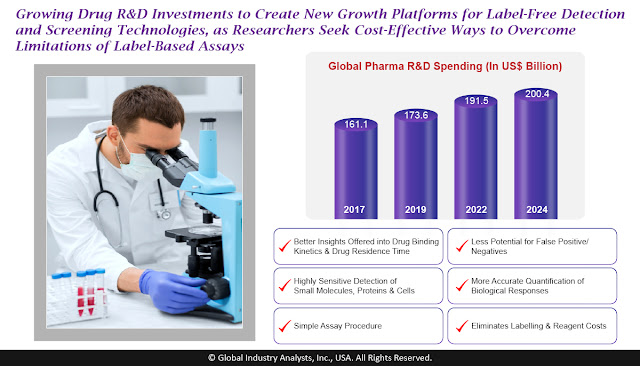The global Label-Free Detection market
is projected to reach US$1.3 billion by 2025, driven by growing drug R&D, rising
competitive pressure to reduce cost of drug development and the resulting need for
cost-effective and efficient screening technologies. Traditional label-based assays
are beset with drawbacks such as high cost associated with label preparation;
lower levels of sensitivity and accuracy as measurements are made indirectly
using a labeled reactant; risk of certain antigen/antibody reactions not being
detected; requires multiple steps and is time consuming; and tendency to modify
the physicochemical or binding properties making accurate drug characterization
difficult. In this regard, label-free assays for biochemical and cell-based
drug discovery is growing in importance due to the many benefits offered such
as ability to identify difficult target classes, better insights offered into
drug binding kinetics and drug residence time; highly sensitive detection of
small molecules, proteins and cells; simple assay procedure; less potential for
false positive/negatives; eliminates labelling & reagent costs; aids in
high-throughput, independent screening of whole cells; provides new insights
into compound action and helps devise better optimization strategies; increased
sensitivity and specificity; more
accurate quantification of biological responses, among others. All of these
benefits are helping replace traditional techniques like radioactive assays, enzyme-labelled
assays (ELISA assays), fluorescent labeled assays, luminescent labeled assays,
and Chemiluminescence immunoassay (CLIA) with label-free options. Read More…
The Global Market for Private Tutoring Services is Forecast to Reach US$227 Billion by 2022
Intense Competition among Students and the Growing Need to Achieve Academic Excellence Drive the Global Private Tutoring Market, According to a New Report by Global Industry Analysts, Inc. GIA launches comprehensive analysis of industry segments, trends, growth drivers, market share, size and demand forecasts on the global Private Tutoring market. The global market for Private Tutoring Services is forecast to reach US$227 billion by 2022 , driven by the need to keep pace with classroom teaching, improve overall competency and enhance knowledge and skill level. Education is considered the social ladder to achieve success in personal and professional life. Higher education is associated with increased opportunities in the labor market, high remunerations, and improved social standing. People are therefore investing heavily in children’s education, including private tutoring or private supplementary tutoring which is emerging as a major phenomenon in the global education system...


Comments
Post a Comment